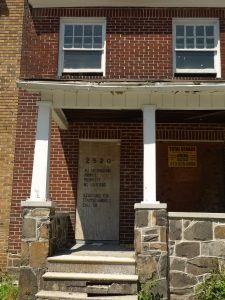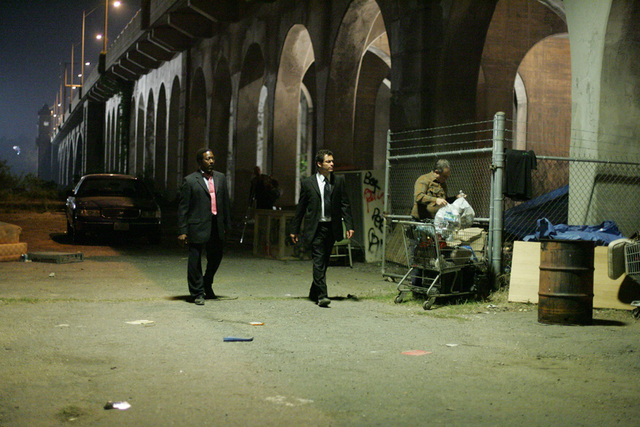Baltimore’s drug war can end in Johns Hopkins Hospital
In 2009, Chris Grayling, Conservative British MP, made comparisons with a section of Manchester, England, to scenes from “The Wire,” setting off a political spat in both nations, including a curt response from then Mayor Sheila Dixon and an editorial in the British Independent newspaper by former Mayor Kurt Schmoke.
The reference Grayling made was to a parallel gang and drug culture that still pervades both Moss Side and Baltimore, but not the London suburb of Surrey that he represents.
Then Dixon responded with her own quip to Grayling’s slight of our city. She compared the reality of living in Baltimore to a BBC murder drama set in the placid country town of Badger’s Drift, filmed incidentally in Grayling’s pastoral Surrey and where there is at least one murder per episode.
Her attempt to comically disarm the perpetual image of Baltimore was a weak one at best against a nation, Great Britain, where most police do not carry guns while on duty and whose addiction, incarceration and murder rates are far below ours. While for most viewers The Wire is a great violent fiction, to those living in Baltimore, it comes across as documentary, as fact.
The Baltimore Sun even used the incident to accept a trade of reporters from the Independent in the hope of comparing cultures and crime strategies. Ironically, while the reporter from London was on a murder scene soon after his arrival in Baltimore, the Sun reporter, I assume on orders from his bosses, spent little time in Moss Side ghetto but instead reported mostly from incomparable London whose murder rate, 136 in 2009, was much lower than Baltimore’s, 238, in a city 12 times our size.
Schmoke, who held office from 1987 to 1999, wrote a more convincing editorial explaining the parallels between the city and the show. He highlighted the mixed message many children, who come from households of addiction, get when they hear an anti drug mantra in school.
He noted how the show tended to focus on the “other Baltimore.” Still, he spread the blame and minimized the effects of the drug trade, its generational effects on expectations for the city while placing the responsibility for it’s current state on the failed “war on drugs.” Sadly, the editorial excluded an earlier viewpoint of his about addiction being a public health issue, not simply a policing issue or an issue for the poor and black.

In opposite, the nation of Scotland has taken a novel approach to its addiction problem by looking inward. In the hope of reducing chemical dependency and increasing economic growth, its 2006 study painted a brutal overall picture of the cost and effects of addiction in stark contrast to our externalizing our addiction problem.
The Scots recognized that the addiction issue, with all its ancillary problems of crime, court costs, dysfunction in families and incarceration were keeping businesses from setting up shop as well as retarding the hopes for the children in families of addiction. Scotland followed the money. As a result, there has been a huge reduction in young addicts as well as a large number of addicts ending their long term use of both heroin and methadone.
To find a more honest assessment of conditions on the ground here in the city, I need only turn to my neighbor, Miss Shirley. She has been on our block in north central Baltimore since 1962 and raised three good kids with her late husband, Robert, a city bus driver.
She refuses to sell her home. She believes in this city. Even so, she will not allow her grandchildren more than 10 yards from her property line. She knows, as I do, that there have been 20 murders in the last five years within five blocks of where we live. She knows we lost another 21-year-old Thursday night, not three blocks away. Harwood is a neighborhood that has gotten worse since the 1990s.
The same is happening on lower Belair and Harford roads. In Edmondson Village, where middle-class black folks were able to raise at least a generation of children in safety, now their children are telling mom and dad to sell and leave the city. So, while investment has come to once-blighted areas like Canton, Harbor East and Federal Hill in the past decade or two, the result has been a regional shift of crime rather than a great reduction.

We have some similarities with Scotland. We both have upwards of 50,000 addicts in a largely homogenous group with highly unemployable people who fund their addictions through illegal means. Still, where Scotland has an addiction rate of one citizen in 50, our rate in Baltimore is one in 12. While we try to find solutions through the far off possibility of legalization, Scotland has sought to reduce the sheer numbers of addicts in the hope of making viable citizens. Where we blame joblessness, bigotry or Afghan poppy farmers under siege of war, Scotland is busy getting people away from addiction.
Let me be clear: I have no qualms with someone who chooses to use drugs. It’s not a moral issue if someone chooses to get high. Still, we have a moral imperative to make sure the young are safe in their homes, their streets and schools which includes the defense of children against the addiction that may be in their families.
Let me be even more clear: if total employment came to Baltimore today, we would still have 50,000 addicts and their families who need help. So, what are we waiting for?
The suggestion I made to my councilman, Carl Stokes, is the same I make to you. Give all drug rehabilitation services and money to Johns Hopkins Hospital with the mandate that it reduce the number of those addicted by a third in four years. That it has a bed and rolling, same day admission for any addict who wants services and that in eight years the number of addicts is reduced another third.
Baltimoreans have a love-hate relation with Hopkins, but everyone knows that in medicine and research, it is at the top of the field, worldwide. We know that whatever it does, it does very well. Since 2011, researchers at Hopkins Bayview have been tracking a small number of addicts (150) using GPS and smart phone devices to map their daily whereabouts. Well, let’s ask that it do a little more than isolated research for the land it has acquired on the east side. In the meantime, it can ask us or a policeman about the habits of the addicted. It’s about the drug, first and last. We know it all too well.
If we do this, we bring down the demand for illegal drugs, still the greatest economic concern in Baltimore. If we do this, we also send a message to employers that we are open for business and welcoming of theirs.
We need to take a Stalinist, very public approach to addiction as a health mandate, using every means at our disposal to diminish the culture of addiction and bring families back to life. If we do, we can also set an example for the nation. If we see what a child of addiction does as his parents look through him toward the days hit, we know we have a problem that we can and must conquer.
Let’s get a grip. There is no “other” Baltimore. There are simply bad neighborhoods with most other neighborhoods waiting for the other shoe to drop. It’s been decades since the streets were safe and clean. Decades since someone from Baltimore City could say as much with pride without seeming to be a lunatic.
This is a strange and beautiful city where most people, even the junkies, say good morning. Still, this is also a city where, except in very few places a woman can’t walk her dog safely in the evening.
(Feature photo from HBO’s “The Wire.”)
Robert Emmet Mara has been in Baltimore since 2006. A native New Yorker, Robert came to Baltimore to do three things: work with kids, renovate houses and write a second book of fiction. Since his arrival, he has managed to do all three and more.
He has sought better oversight for his still blighted Harwood neighborhood from the city and has been asked to speak to various community association leaders on the subject of city agency relations.


Good article—I’m a little confused about how Scotland followed the money to reduce the drug problem ?—Interesting idea for Hopkins and sounds expensive